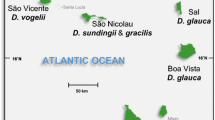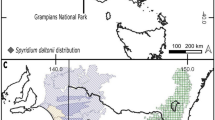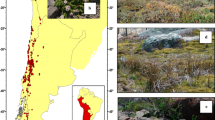Abstract
Using the analysis of nine isozyme systems and cladistic analysis of 32 morphological characters of the Mexican species of the section Dutra of the genus Datura, evidence was sought on the origin of the cultivated D. metel L. The genetic similarity and the phylogenetic relationship suggest that D. metel is related more closely to D. inoxia Mill. than to the other taxa of the section Dutra based upon the small genetic distance between them. The cladistic analysis revealed two main clades: the long-lived, tuberous rooted perennials (D. inoxia, D. lanosa A.S. Barclay ex Bye, D. metel, and D. wrightii Regel) and the tap-rooted annuals (D. discolor Bernh., D. kymatocarpa A.S. Barclay, D. leichhardtii F.V. Muell. ex Benth. ssp. pruinosa (Greenm.) Barclay ex Hammer (syn.: D. pruinosa Greenm.), D. reburra A.S. Barclay). Datura inoxia is the sister taxon of D. metel next to which is D. wrightii while D. lanosa is the basal taxon of this group. The combination of genetic and cladistic data indicates that D. inoxia is most likely the progenitor of D. metel.



Similar content being viewed by others
References
An-ming L (1986) Solanaceae in China. In: D’Arcy WG (ed) Solanaceae: biology and systematics. Columbia University Press, New York, pp 79–85
Ashman TL, Schoen DJ (1994) How long should flowers live? Nature 371:788–791
Ashton GC, Braden AWH (1961) Serum β-globulin polymorphism in mice. Aust J Biol Sci 14:248–254
Avise JC (1994) Molecular markers, natural history and evolution. Chapman & Hall, New York
Baverstock PR, Moritz C (1996) Project design. In: Hillis DM, Moritz C, Mable BK (eds) Molecular systematics. Sinauer Associates Inc, Sunderland, pp 17–27
Bolnick DI, Fitzpatrick BM (2007) Sympatric speciation: models and empirical evidence. Annu Rev Ecol Evol Syst 38:459–487
Brown AHD, Weir BS (1983) Measuring genetic variability in plant populations. In: Tanksley SD, Orton TJ (eds) Isozymes in plant genetics and breeding, part A. Elsevier, Amsterdam, pp 219–239
Bye RA, Mata R, Pimentel J (1991) Botany, ethnobotany and chemistry of Datura lanosa (Solanaceae) in Mexico. Ann Inst Biol (UNAM) Serie Bot 61:21–42
Carmona-Jiménez ML (2003) Estudio anatómico y morfológico de las semillas de Datura spp. en México. Tesis de Maestría en Ciencias, Facultad de Ciencias, Universidad Nacional Autónoma de México, México, DF
Cheliak WM, Pitel JA (1984) Techniques for starch gel electrophoresis of enzymes from forest tree species. Petawa Forestry Institute, Canadian Forestry Service Agriculture, Ottawa
Colunga-García Marín P, Coello-Coello J, Eguiarte LE, Piñero D (1999) Isozymatic variation and phylogenetic relationships between henequen (Agave fourcroydes) and its wild ancestor A. angustifolia (Agavaceae). Am J Bot 86:115–123
Conkle MT, Hodgskiss PD, Nunnaly LB, Hunter SC (1982) Starch gel electrophoresis of conifer seeds: a laboratory manual. General Technical Report PSW-64, USDA Forest Service Pacific Southwest Forest and Range Experimental Station, Berkeley, CA
Conklin ME, Smith HH (1971) Peroxidase isozymes: a measure of molecular variation in ten herbaceous species of Datura. Am J Bot 58:688–696
Darwin C (1883) The variation of animals and plants under domestication. D Appleton and Co, New York
De Candolle A (1852) Prodromus systematis naturalis regni vegetabilis. Masson, Paris
Deb DB (1979) Solanaceae in India. In: Hawkes JG, Lester RN, Skelding AD (eds) The biology and taxonomy of the Solanaceae. Academic Press, London, pp 87–112
Dethier M, Demeyer K, Cordier Y (1993) Cultivation of Datura species for scopolamine and hyoscyamine production in Burundi. Acta Hortic 331:39–48
DeWolf GP (1956) Notes on cultivated Solanaceae 2 Datura. Baileya 4:12–23
Doebley J (1989) Isozymic evidence and the evolution of crop plants. In: Soltis DE, Soltis PS (eds) Isozymes in plant biology. Dioscorides Press, Portland, pp 165–191
Evans WC (1979) Tropane alkaloids of the Solanaceae. In: Hawkes JG, Lester RN, Skelding AD (eds) The biology and taxonomy of the Solanaceae. Academic Press, London, pp 241–254
Felsenstein J (1985) Confidence limits on phylogenies: an approach using the bootstrap. Evol 39:783–791
Fildes RA, Harris H (1966) Genetically determined variation of adenylate kinase in man. Nature 209:262–263
Fuentes V (1980) Solanaceas de Cuba I Datura L. Rev Jard Bot Nac Cuba 1:61–81
Fuentes V, Lima H (1983) Isoenzimas peroxidasa en el género Datura L. III. Rev Jard Bot Nac Cuba 4(2):49–63
Gentry JL, D’Arcy WG (1986) Solanaceae of Mesoamerica. In: D’Arcy WG (ed) Solanaceae: biology and systematics. Columbia University Press, New York, pp 15–26
Haegi L (1976) Taxonomic account of Datura L. (Solanaceae) in Australia with a note on Brugmansia Pers. Aust J Bot 24:415–435
Hammer K, Romeike A, Tittel C (1983) Vorarbeiten zur monographischen Darstellung von Wildpflanzensortimenten: Datura L., section Dutra Bernh., Ceratocaulis Bernh. et Datura. Kulturpflanze 31:13–75
Hancock JF (1992) Plant evolution and the origin of crop species. Prentice Hall, NJ
Harlan JR (1992) Crops and man. American Society of Agronomy & Crop Science Society of America, Madison
Hegnauer R (1973) Chemotaxonomie der pflanzen. Birkhäuser Verlag, Basel
Hegnauer R (1990) Chemotaxonomie der pflanzen. Birkhäuser Verlag, Basel
Hernández-Verdugo S, Luna-Reyes R, Oyama K (2001) Genetic structure and differentiation of wild and domesticated populations of Capsicum annuum (Solanaceae) from Mexico. Plant Syst Evol 226:129–142
Jain SK, Borthakur SK (1986) Solanaceae in Indian tradition, folklore, and medicine. In: D’Arcy WG (ed) Solanaceae: biology and systematics. Columbia University Press, New York, pp 577–583
Jiao M, Luna-Cavazos M, Bye R (2002) Allozyme variation in Mexican species and classification of Datura (Solanaceae). Plant Syst Evol 232:155–166
Leht M, Jaaska V (2002) Cladistic and phenetic of relationships in Vicia subgenus Vicia (Fabaceae) by morphology and isozymes. Plant Syst Evol 232:237–260
Linneaus C (1753) Species Plantarum. Stockholm
Lockwood TE (1973) Generic recognition of Brugmansia. Bot Mus Lealf Harv Univ 23:273–284
Luna-Cavazos M, Jiao M, Bye R (2000) Phenetic analysis of Datura section Dutra (Solanaceae) in Mexico. Bot J Linn Soc 133:493–507
Mace EC, Gebhardt CG, Lester RN (1999) AFLP analysis of genetic relationships in the tribe Datureae (Solanaceae). Theor Appl Genet 99:634–641
McLeod MJ, Guttman SI, Eshbaugh WH, Rayle RE (1983) An electrophoretic study of evolution in Capsicum (Solanaceae). Evol 37:562–574
Nei M (1972) Genetic distance between populations. Am Nat 106:283–292
Ohnishi O (1998) Search for the wild ancestor of buckwheat III. The wild ancestor of cultivated common buckwheat and of tatary buckwheat. Econ Bot 52:123–133
Ohnishi O, Matsuoka H (1996) Search for the wild ancestor of buckwheat II. Taxonomy of Fagopyrum species based on morphology, isozymes and cp-DNA variability. Genes Genet Syst 71:383–390
Oliver JL, Martinez-Zapater JM (1984) Allozyme variability and phylogenetic relationships in the cultivated potato (Solanum tuberosum) and related species. Plant Syst Evol 148:1–18
Olmstead RG, Palmer JD (1992) A chloroplast DNA phylogeny of the Solanaceae: subfamilial relationships and character evolution. Ann Mo Bot Gard 79:346–360
Palomino G, Viveros R, Bye RA (1988) Cytology of a five Mexican species of Datura L. (Solanaceae). Southwest Nat 33:85–90
Persson V, Knapp S, Blackmore S (1999) Pollen morphology and the phylogenetic analysis of Datura L. and Brugmansia Pers. In: Nee M, Symon D (eds) Solanaceae IV. Royal Botanic Gardens Kew, Richmond, pp 171–178
Potter D, Doyle JJ (1992) Origins of the African yam bean (Sphenostylis stenocarpa, Leguminosae): Evidence from morphology, isozymes, chloroplast DNA, and linguistics. Econ Bot 46:276–292
Poulik MD (1957) Starch electrophoresis in a discontinuous system of buffers. Nature 180:1477
Reynolds J, Tampio J (1983) Double flowers—A scientific study. Scientific and Academic Editions, New York
Rieseberg LH, Beckstrom-Sternberg SM, Liston A, Arias DM (1991) Phylogenetic and systematic inferences from chloroplast DNA and isozyme variation in Helianthus sect. Helianthus (Asteraceae). Syst Bot 16:50–76
Rohlf FJ (2000) NTSYS-pc, numerical taxonomy and multivariate analysis system, version 2.1. Applied Biostatistics, Inc, New York
Safford WE (1921) Synopsis of the genus Datura. J Wash Acad Sci 11:173–189
Satina S (1959) Segmental interchanges and the species problem. In: Avery AG, Satina S, Rietsema J (eds) Blakeslee: the genus Datura. Ronald Press, New York, pp 220–234
Satina S, Avery AG (1959) A review of the taxonomy history of Datura. In: Avery AG, Satina S, Rietsema J (eds) Blakeslee: the genus Datura. Ronald Press, New York, pp 16–47
Soltis DE, Soltis PS (eds) (1989) Isozymes in plant biology. Dioscorides Press, Portland
Spooner DM, Lara-Cabrera S (2001) Sistemática molecular y evolución de plantas cultivadas. In: Hernández HM, García-Aldrete AN, Álvarez F, Ulloa M (eds) Enfoques contemporáneos para el estudio de la biodiversidad: Instituto de Biología. Universidad Nacional Autónoma de México, México, pp 57–114
Stevens PF (1991) Character states, morphological variation, and phylogenetic analysis: a review. Syst Bot 16:553–583. doi:10.2307/2419343
Stuber CW, Johnson FM (1977) Genetic control and racial variation of β-glucosidase isozymes in maize (Zea mays L.). Biochem Genet 15:383–394
Stuber CW, Wendel JF, Goodman MM, Smith JSC (1988) Techniques and scoring procedures for starch gel electrophoresis of enzymes from maize (Zea mays L.). Technical Bulletin 286, North Carolina Agricultural Research Service, North Carolina State University, Raleigh, NC
Stuessy TS (1990) Plant taxonomy, the systematic evaluation of comparative data. Columbia University Press, New York
Swofford DL (1998) PAUP, phylogenetic analysis using parsimony. Version 4. Sinauer Associates, Sunderland
Symon D, Haegi LAR (1991) Datura (Solanaceae) is a New World genus. In: Hawkes JG, Lester RN, Nee M, Estrada N (eds) Solanaceae III: taxonomy, chemistry, evolution. Royal Botanic Gardens Kew, Richmond, pp 197–210
Tétényi P (1987) A chemotaxonomic classification of the Solanaceae. Ann Mo Bot Gard 74:600–608
Watrous L, Wheeler Q (1981) The outgroup method of phylogeny reconstruction. Syst Zool 30:1–16
Wendel JF, Weeden NF (1989) Visualization and interpretation of plant isozymes. In: Soltis DE, Soltis PS (eds) Isozymes in plant biology. Dioscorides Press, Portland, pp 5–45
Zohary D, Hopf M (1994) Domestication of plants in the Old World. Clarendon Press, Oxford
Acknowledgements
We thank Alfredo Cervantes, Fernando Chiang, Patricia Dávila, Alfonso Delgado, Patricia Escalante, Victor Fuentes, Les Landrum, Gary Nabhan, Juan Nuñez-Farfán, Porfirio Ramírez, David Spooner, Oswaldo Tellez, and John Turrell for their suggestions and helpful reviews during the development of this work. We acknowledge the bibliographic, field, and technical assistance of José Arellano, Jennifer Bain, Francisco Basurto, Bruce Bartholomew, Germán Bojórquez, Lourdes Carmona, Rafael Corral, Carlos Díaz, Francisco Felix, Oscar Ferrera, Raymundo García, Martín Hilerio, Elia Herrera, Ma. Antonieta Isidro, Edelmira Linares, Rigoberto López, Gilberto Márquez, Miguel Ángel Martínez, Myrna Mendoza, Gustavo Morales, Eduardo Palacios, Isaac Reyes, Lourdes Rico, Joel Rodríguez, Victoria Sosa, Richard Spellenberg, Miguel Trejo, and Hugh Wilson. The main electrophoresis works were carried out at the Laboratory of Electrophoresis of Instituto de Biología de la UNAM; special thanks go to Fernando Cervantes and members of his group. Nidia Pérez from the Instituto de Ecología de la UNAM provided initial guidance for electrophoresis techniques. Partial financial support for this work was provided by Comisión Nacional para el Conocimiento y Uso de la Biodiversidad (Project 088), International Cooperative Biodiversity Groups (“Bioactive agents from dryland biodiversity of Latin America” grant U01 TW 00316 from the National Institutes of Health, National Science Foundation, and USAID), and Universidad Nacional Autónoma de México. CONACYT provided partial scholarship support to Mario Luna-Cavazos. Dirección General de Asuntos del Personal Académico de la Universidad Nacional Autónoma de México provided a partial scholarship to Meijun Jiao.
Author information
Authors and Affiliations
Corresponding author
Rights and permissions
About this article
Cite this article
Luna-Cavazos, M., Bye, R. & Jiao, M. The origin of Datura metel (Solanaceae): genetic and phylogenetic evidence. Genet Resour Crop Evol 56, 263–275 (2009). https://doi.org/10.1007/s10722-008-9363-5
Received:
Accepted:
Published:
Issue Date:
DOI: https://doi.org/10.1007/s10722-008-9363-5




